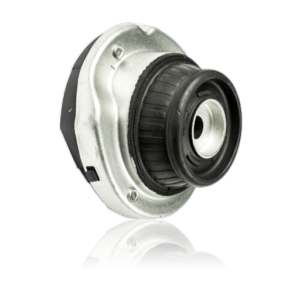Strut mount
SELECT YOUR VEHICLE TO FIND THE RIGHT PARTS!

All you need to know about turret bearing
MacPherson strut is the name of the part of the shock absorber, which is connected to the chassis. The function of this part is to dissipate the vibration coming from the shock absorber. The strut is composed of the following parts: rubber seal ring, bearing in case of the front shock absorbers, protecting seal and upper supporting washer.
What to look for?
The operating life of the strut is 1.5-2 years, but it is important to check its conditions on a regular basis. If the vehicle travels frequently on poor quality roads or among difficult operating conditions, then the part could deteriorate significantly.
The problems related to the strut could be recognised from the signs that are similar to what are caused by the faults of other parts of the suspension. Since the bearings of the shock absorbers are exposed to high load, it often occurs that the signs warning about the shock absorbing system are actually caused by the fault or damage of the strut. If a knocking sound is heard from the direction of the running gear, and the driving of the vehicle becomes more difficult, then it is absolutely necessary to consult the problem with an expert.
Faults of the part
- Worn, broken rubber part
- Worn bearing
- Corroded metal parts
Sign of faulty part
- The vehicle is hard to handle in turns
- Rattling, knocking sound
- Steering wheel vibrates on poor quality roads
- Wheel camber is inadequate
- Wearing on the running surface
Reasons of faulty parts
- Poor quality installed parts
- Material defect
- Water or dust gets into the parts
- Operation at very high or very low temperatures
- Poor quality roads
- Inadequate service cycle
Replacing the strut
The part is to be replaced as soon as possible if the rubber part is fissured, the bearing is worn, or the clearance between the washer the protecting seal exceeds 1 cm. For replacing the strut, first loosen the strut and the brake hoses, then remove the nut from the connection to the vehicle body, then pull the strut outwards somewhat. Fix the part, then compress the spring with a plier. Unscrew the nut from the central lever, and remove the struct, then dismount the part from the spring nest. Replace the bearing, use new bushing, and lubricate the bearing with special lubricant. Install the upper washer, the bearing, the protecting seal and finally the lower washer. For assembling the strut, it is required to carry out the above operations in reversed order.
FAQ
Look around in the help center.
Where and why is the tower bearing responsible?
When cars are manufactured, the lower half of the shock absorber is firmly attached to the wheel hub. This is important because as a result of moving the steering wheel, the wheel hub moves left and right, and thus the shock absorber as well. However, if the upper half of the shock absorber were also fixed, it would not be able to turn. That is why the top of the telescope is usually attached to the tower bearing, which keeps the shock absorber in the center, but can also rotate if necessary. The top of the front shock absorber is therefore not connected to the body, but to the tower bearing, and then to the tower plate.
This mechanism allows the tower bearing to perform its tasks flawlessly. It has many indispensable functions; the most important of these are that it facilitates steering, keeps the stilt (McPherson) suspension in motion or reduces the spring force acting upwards.
Phenomena indicating a fault
If a tower bearing has been properly designed and protected from the factory, it will generally not fail. There are several reasons for the failure of a tower bearing that is not of perfect quality. Examples include the wear and tear associated with use, corrosion due to insufficient protection, and the tower bearing breaking out of the tower silencer.
The part in question carries the entire weight of the car and works as a track bearing. According to popular belief, if you hear a knocking sound coming from the undercarriage, it is probably because of a failed tower bearing. But the popping sound coming from the tower is actually the internal mechanism of the shock absorber, but it can also be the stabilizing rod fixed on the stilt or the collapsing tower silencer. On average, knocking caused by the tower bearing can only occur approximately in every 10th car. And with these, it could certainly have happened that the designers developed a bad construction at the factory, in which the principle of the track bearing does not apply. As everywhere, of course, the exception proves the rule.
